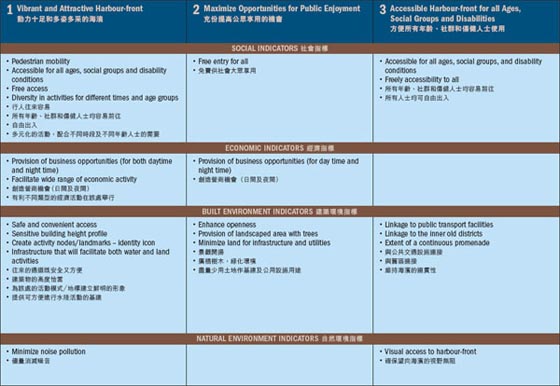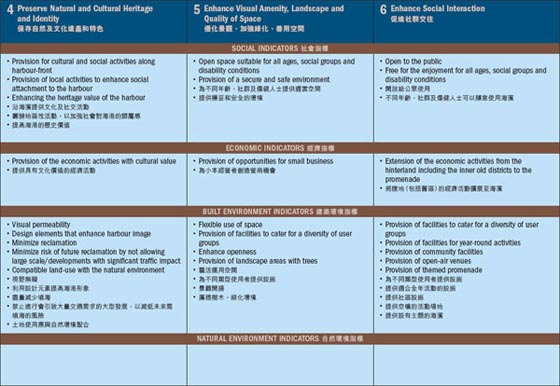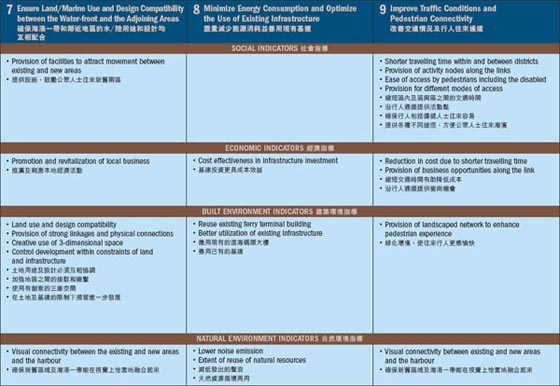| The Way Forward- a Hong Kong Regional Heliport |
With the building of a heliport adjoining Golden Bauhinia Square, the helicopter industry intends to work with government, the community and other interested parties to create an attractive facility serving the local community, business travellers and tourists alike.
The heliport will be a gateway to the Pearl River Delta and a gateway into Hong Kong, spectacular in its setting, providing opportunities to showcase Hong Kong at its best.
| 1. Our Proposal |
| We propose that the heliport adjacent to Golden Bauhinia Square earlier earmarked for Government Flying Service exclusive use be redesigned for shared use. The heliport will be planned as a sustainable integral part of an existing harbour-front amenity area. |
|

| 2. Why is a public heliport required? |
The public heliport will bring significant direct and indirect economic benefits to Hong Kong .
| 2.1 |
There is a genuine and urgent need for a permanent public heliport for both domestic and single-engine ad hoc cross-border services for swift point to point transportation. |
| |
|
|
| 2.2 |
Government has estimated that between now and 2020, the demand for domestic private helicopter services will grow at an average of 6.3% per annum. At this rate, the number of domestic flights will increase by more than 50% between 2003 and 2010 [LC Paper No. CB(1)376/04-05(04)]. There is also a significant and growing pent-up demand for the yet untapped cross-border helicopter charter market. The MVA consultancy study on Helicopter Traffic Demand and Heliport Development in Hong Kong issued in August 2002 projected that the growth in demand for cross-border helicopter services between Hong Kong and the Pearl River Delta (including Macau ) could be approximately 9.4% p.a. up to 2020. As illustrated in the MVA report, projected helicopter traffic between Hong Kong and the Pearl River Delta (excluding Macau ) would actually be considerably greater. This further highlights the need for a ground level heliport in the CBD given that the vast majority of helicopter travel between Hong Kong and the Pearl River Delta is expected to be single-engine helicopters, which are forbidden to land on elevated helipads. |
| |
|
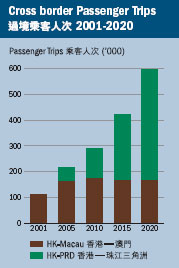 |
| 2.3 |
Hong Kong is the largest investor in the Pearl River Delta with total investment reaching HK$1,170 billion at the end of 2004. In recent years government, business and community groups on both sides of the border have stepped up efforts to promote the economic integration of Hong Kong and the Pearl River Delta. Inbound tourism from the Mainland is at a record high, and rising. In short, Hong Kong is emerging as the key service hub for the entire region. |
| |
|
| 2.4 |
To gain perspective of the size of the potential market to be served by the heliport, we would note that the area of the Pan Pearl River Delta encompasses some 420 million people; in other words the same number as the whole of Europe . |
| |
|
|
| |
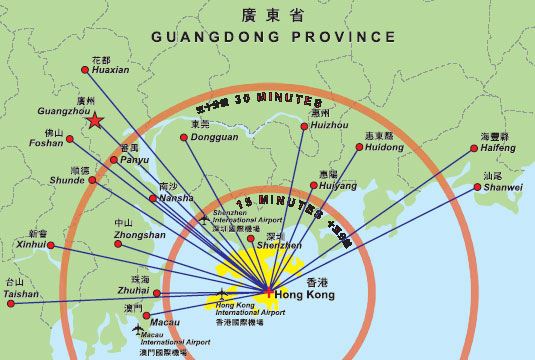 |
| |
|
|
| 2.5 |
By helicopter, Hong Kong is only 30 minutes away from anywhere in the Pearl River Delta. A typical ferry or road journey could take two to four hours. The time advantage provided by helicopter services brings a real and valuable competitive business edge to Hong Kong . The Hong Kong economy and therefore the entire community will benefit greatly through unlocking this important yet virtually untapped market. |
A working harbour-front should be regarded as a part of the economic engine of Hong Kong - essential to the SAR's prosperity and future development. |
|

| 3. Why does the heliport have to be located in the Central Business District? |
| The main advantages of a helicopter journey are speed and accessibility. It therefore follows logically that a heliport must be located in the Central Business District in order to generate maximum benefit for the community at large. It should be conveniently located for tourists and the business community alike and should provide easy connectivity with other modes of transportation. |
|

| 4. How can the heliport be integrated into a vision of a vibrant and interesting harbour-front promenade? |
Whereas there are obvious measures that have to be taken to ensure the security of the facility, there is certainly no reason why the spectacle of helicopters arriving and departing from the heliport cannot be enjoyed by the public. Indeed even the old heliport at Central attracted spectator interest with onlookers watching through the metal bars that created the barrier between the adjoining pavement and the facility. We propose retaining the existing three-storey ferry building at the Golden Bauhinia Square but only after considerably upgrading the structure to improve its overall visual appearance. Impressions of this structure after revamping are illustrated herein.
This building would be redesigned to create easy access to the public for recreation purposes and will serve four important functions.
| 4.1 |
It will provide a noise barrier between the heliport proper and the adjacent Golden Bauhinia Square . |
| |
|
| 4.2 |
It will offer public restaurant facilities as well as a public viewing platform on the roof. |
| |
|
| 4.3 |
Part of the building could be used as exhibition space. Relevant options could include an exhibition celebrating the handover; a history of harbour reclamation; or a helicopter and seaplane museum highlighting the vital role both have played in Hong Kong's development forming the first intercontinental links between the North America and Asia . |
| |
|
| 4.4 |
It will provide mutually exclusive heliport facilities for the Government Flying Service and the commercial operators. |
As will be clear from the illustrations of this building, its retention in its redefined form will add considerable interest to the surroundings and provide a valuable amenity that will be available to the general public whether they are using the heliport facility or not. |
|

| 5. Can the additional reclamation required for the heliport be justified under the terms of the Protection of the Harbour Ordinance? |
| 5.1 |
A compelling present public need for reclamation. |
| |
The argument has been made elsewhere that there is compelling and present need for a public heliport within the Central Business District to serve single-engine aircraft. If the heliport is to be provided of a size that will be sustainable for future requirements, limited reclamation cannot be avoided. |
| |
|
| 5.2 |
There is no reasonable alternative. |
| |
- Government Studies indicate that the only alternative site for a heliport is at Sheung Wan and this has been essentially now rejected as being located too close to the residential area at Western.
- Government Flying Service have indicated that the site adjacent to the Golden Bauhinia Square is the only site that meets their security needs.
|
| |
|
| 5.3 |
The reclamation is kept to the minimum. |
| |
- The total reclamation involved for this site is 2,600 sq. metres. Taking into account the forecast growth of demand and the fact that this will be the only site in Hong Kong shared between the government and the single-engine commercial operators, this size is considered the minimum required within the restraints of the principle of sustainability.
- Recognizing the importance of this matter and the need to comply with the provisions of the Protection of the Harbour Ordinance, we have taken legal advice from eminent counsel and his advice is attached herewith as Appendix 2. This confirms our own belief that the construction of a heliport at this site of the size contemplated would be legal and thus fall within the terms and conditions of the Motion passed by the Legislative Council Joint Panels on 28 February 2005.
|
|
|

| 6. Why cannot the existing heliport at Sheung Wan be used? |
| 6.1 |
Currently the only centrally located helipad on Hong Kong Island is at the Shun Tak Centre (Macau Ferry Terminal). This caters exclusively for twin-engine helicopters operating scheduled cross-border services. The restriction to twin-engine helicopters is dictated by Hong Kong Civil Aviation Department regulations that forbid operation of single-engine helicopters from elevated helipads. |
| |
|
| 6.2 |
Over 80% of the local private sector helicopter fleet are single-engine and this preference for single-engine helicopters is mirrored in international markets. Single-engine helicopters are fast, capable, safe and economical to operate. Operating statistics show that they are as safe or safer than twin-engine machines. Single-engine helicopters also generate less noise than twin-engine machines. However, they must be operated from ground level helipads. |
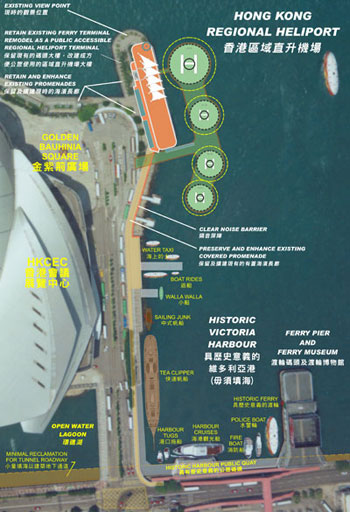
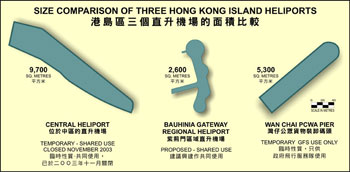 |
|

| 7. What are government's and the helicopter industry's views regarding the sharing of the heliport planned to be adjacent to the Golden Bauhinia Square? |
| 7.1 |
Government |
| |
The Permanent Secretary for Economic Development and Labour has stated in a letter dated 17 March 2005 that, ¡§We have come to the view that the best way forward is to proceed with the re-provisioning of the government helipad at HKCEC and, having taken into account the Legco's Joint Panel's motion, to allow the shared uses of such facility by commercial operators.¡¨ |
| |
|
| 7.2 |
Legislative Councillors |
| |
Legco's Joint Panel's Motion of 28 th February, 2005 stated ¡§That, the Panel on Economic Services and the Panel on Planning, Lands and Works urge the government to expedite the provision of a permanent commercial heliport and associated facilities in the central business district of the Hong Kong Island, and, under the principle of no unlawful reclamation, allow the heliport at the Hong Kong Convention and Exhibition Centre to accommodate both commercial uses by helicopter operators and government uses.¡¨ |
| |
|
| 7.3 |
Industry |
| |
We believe that Hong Kong 's interests are best served by combining a single heliport to be shared by both the private sector and Government Flying Service.
- The helicopter industry has hitherto always shared heliports with the Government Flying Service without difficulty on either side.
- A single, shared facility would create economic synergies and help the community make better use of scarce harbour resources.
- The contour of the shoreline at this site allows the heliport to be optimally integrated into an active harbour-front.
- The ground-level site adjacent to Golden Bauhinia Square is the most suitable for the combined facility. This location, at a maximum distance from the foreshore, restricts helicopter flights to a less noise sensitive area over the water.
|
|
NOISE ABATEMENT PHILOSOPHY
- Typical passenger helicopter noise at source is on the order of approximately 90 dBA. Perceived intensity of this noise will vary inversely with the square of the distance from source. As the distance from the source is doubled, the noise intensity is decreased by a factor of four. For noise sensitive receivers at 400 metres from the source, the perceived noise will be on the order of 30 dBA - typically less than the ambient urban noise levels.
- The two-storey terminal building will itself provide a natural noise and visual barrier in the immediate vicinity.
- An engineered noise barrier will be installed on the west and south boundaries of the heliport.
- The latest in noise mitigation technology will be included in the design and construction of the heliport.
- Noise reduction flight profiles and techniques will be rigorously adhered to.
- Hours of operation would be limited in response to community needs.
|
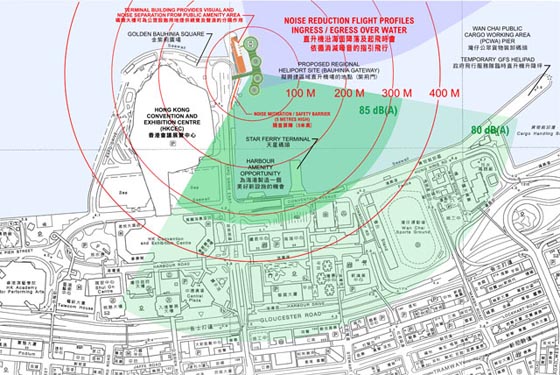 |
|

| 8. Will the heliport as envisaged by the RHWG result in any additional pedestrian and vehicular traffic and if so, how will this increase be dealt with? |
| The additional volume of traffic both pedestrian and vehicular generated by the construction of the heliport will be negligible relative to what exists today and is anticipated in the future. The existing road network and pedestrian bridges linking the area with Wan Chai are more than sufficient to meet the heliport's requirements. |
|

| 9. Should the heliport be for domestic use only or should it also cater for cross-border movements? |
| To meet the potential for both domestic and Hong Kong-Pearl River Delta charter demand, any proposed ground-level heliport within the Central Business District must cater to both domestic and cross-border services. |
|

| 10. Will the proposed heliport adjacent to the Golden Bauhinia Square create a noise problem for the residents of Wan Chai and adjoining areas? |
| 10.1 |
The proposed site adjoining Golden Bauhinia Square is located well away from residential buildings and is thus far less noise sensitive than any other on the north shore of Hong Kong Island . At the residential buildings along Jaffe Road , the noise of helicopter traffic would be indistinguishable from the background noise. (See the Mott Connell study on noise impact assessment at Appendix 1.) |
| |
|
| 10.2 |
There is no alternative site on the harbour-front that can be located further from a residential area than the proposed site. An alternative site originally proposed at Sheung Wan was heavily criticized by the Central and Western District Council as being too close to residential areas. |
|
|

| 11. Will the Hong Kong public benefit from the construction of a heliport? |
| 11.1 |
The RHWG's goal is to make the Hong Kong Regional Heliport a key attraction in its own right, designed to encourage active participation and enjoyment by the broad community. Experience from Hong Kong's previous centrally located heliports has shown that helicopters are a popular attraction for both Hong Kong people and visitors. With a creative approach, the Hong Kong Regional Heliport adjacent to Golden Bauhinia Square will be a popular community amenity. |
| |
|
| 11.2 |
The views of the community are being sought on the best way to integrate the heliport within the harbour-front promenade. Subject to the community's views, the existing harbour-front ferry pier can be outfitted with a viewing lounge and a helicopter/aviation museum to entertain and educate both the young and adults. In addition, other public amenities could include aviation themed gift shops, educational displays, restaurants, coffee shops, etc. |
| |
|
| 11.3 |
A heliport, if properly designed and integrated into the urban fabric, will be an attractive amenity providing one element of a vibrant, active, accessible and interesting harbour-front. |
|
|

| 12. Criteria to be Applied in the Selection of a Surface Level Heliport in the CBD |
We believe that the site adjacent to Golden Bauhinia Square is the only site that meets all the criteria.
| 12.1 |
Ground level: The Hong Kong Civil Aviation Department will not allow single-engine helicopters to land on any raised structure. This restriction would apply even to single-story structures such as the roofs of passenger ferry piers.
Site adjacent Golden Bauhinia Square : This site meets the required criteria.
Other potential sites: Whilst it is possible to come up with theoretically suitable sites such as Victoria Park, the reality of the situation is that no inland site would be acceptable for the construction of a heliport. |
| |
|
| 12.2 |
On the harbour-front: Although strictly speaking it is not necessary to have the heliport located on the harbour-front at ground level, for all practical purposes due to the approach and landing glide slopes and other inland activities, the helipad needs a location on the harbour-front.
Site adjacent Golden Bauhinia Square : This site meets the required criteria.
Other potential sites: There are sites available other than that of Golden Bauhinia Square . One is the Wan Chai PCWA Pier off the Yacht Club now used by the Government Flying Service. It may also be possible to ¡§carve out¡¨ a section of the current reclamation in Central although no particular part of this reclamation currently appears suitable for this. |
| |
|
| 12.3 |
As far as possible from residential areas: Although the noise from helicopters is less than that of a busy thoroughfare, residential areas usually object to having a heliport sited in their close vicinity. Thus ideally any heliport should be placed on a promontory within the harbour well away from residential blocks of flats. Proximity to offices and other non-residential buildings does not present a problem on account of noise due to the fact that such buildings are invariably well insulated against sound.
Site adjacent Golden Bauhinia Square : This site meets the required criteria and would have no adverse effect on the Wan Chai Residential District.
Other potential sites: The use of the PCWA Pier off the Yacht Club was objected to by the Wan Chai District Council with such objections sufficiently vocal as to prevent its use by the commercial helicopter operators. Similarly a site in Sheung Wan was objected to by the Central and Western District Council as being too close to residential buildings. Unless a site can be found on the new Central Reclamation, it would appear that there are no other sites for the heliport other than that adjacent to Golden Bauhinia Square . |
| |
|
| 12.4 |
Central Business District Location: The whole essence of a heliport is that it provides a fast and convenient mode of transportation to the community. This is most needed in the Central Business District being the nodal hub of the SAR's existing transportation network.
Site adjacent Golden Bauhinia Square : This site meets the required criteria.
Other potential sites: There are no other potential sites within the Central Business District that meet all the requisite criteria. |
| |
|
| 12.5 |
Road Access: Although not by any means a major generator of traffic, there must be easy vehicular access to the heliport. Anything other than minimal vehicle parking is not required.
Site adjacent Golden Bauhinia Square : This site meets the required criteria.
Other potential sites: There are no other potential sites within the Central Business District that meet all the requisite criteria. |
| |
|
| 12.6 |
Public Transportation Links: A sizeable proportion of users of the heliport will wish to use public transport. Accordingly there must be available close by ferry, bus and MTR connections.
Site adjacent Golden Bauhinia Square : This site meets the required criteria.
Other potential sites: There are no other potential sites within the Central Business District that meet all the requisite criteria. |
| |
|
| 12.7 |
Assimilation with the Surrounding Area: Any heliport must be part of a vibrant and working harbour-front and not separated from it as has always been the case in the past.
Site adjacent Golden Bauhinia Square : This site only meets the required criteria if the existing ferry terminal building is joined with the heliport thus providing a natural noise barrier thereby providing a means for assimilation with other harbour-front activities. If the scheme originally proposed by government were adopted, the ferry terminal building would be demolished and the heliport would be totally alienated from its surroundings by the erection of noise barriers.
Other potential sites: There are no other potential sites within the Central Business District that meet all the requisite criteria. |
| |
|
| 12.8 |
Sustainability: The heliport must be constructed to a size that meets the requirements of the foreseeable future.
Site adjacent Golden Bauhinia Square : This site would meet the requisite criteria but only if some minimal reclamation amounting to 2,600 sq. metres is permitted.
Other potential sites: There are no other potential sites within the Central Business District that meet all the requisite criteria. |
| |
|
| 12.9 |
Community Involvement: The heliport must be sufficiently accessible and include public recreational amenities.
Site adjacent Golden Bauhinia Square : This site is very accessible and our proposal is to retain the existing building partially for public recreational amenities.
Other potential sites: There are no other potential sites within the Central Business District that meet this criteria. |
MATRIX TO DEMONSTRATE THE HELIPORT'S SUSTAINABILITY PRINCIPLES AND INDICATORS
|
|

|

















